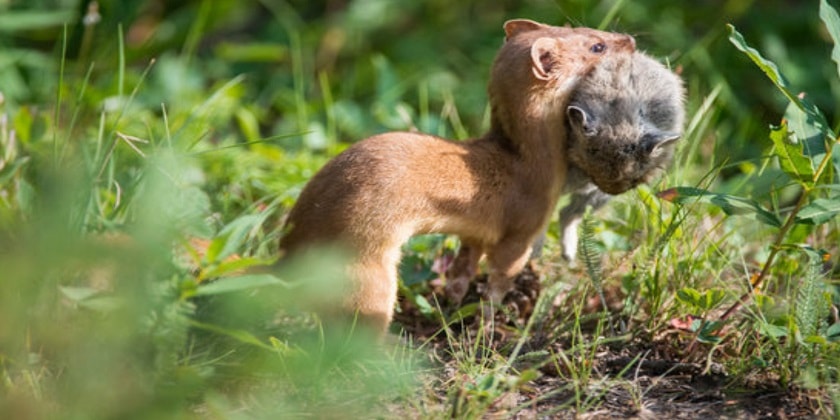You might have known about this small but deadly animal, but you know where do weasels live? Well in this article we are going to discuss the habitat, behaviour and a few interesting facts about the weasel.

These small members of the genus Mustela are known as active predators with long as well as slender bodies and small legs. The few more members of this family are mink, martens, fishers, wolverines, badgers, and skunks. They may look cute and cuddly but they really are small beasts. They are small-sized carnivores and are found on every continent except Australia.
Description
Weasels are usually found in black, brown or grey colour with yellow or white shades. They have a cylindrical shape of body and neck, slender and long body that helps them to follow their prey into burrows. Their underparts are usually creamy white. Weasels have a really sharp eye set and excellent hearing ability which they use in hunting prey.
Weasels shed their fur twice a year, in the spring and in the fall. They shed in response to changes in day length. The fur of weasels in northern parts becomes white in the winter and brown in the summer, while those in southern populations mostly remain brown year-round.
Size
Weasel size varies from 6.7 to 8.8 inches. Females are found smaller than males and usually have the red or brown colour of the upper coat and white in bellies. The tail can be 1 to 2 inches long. Their weight is counted between 120 to 200 g and weasels can run at the speed of 25kmph. An average weasel can live between 1 to 3 years.
Where Do Weasels Live?
Weasels live in various habitats, mostly in open fields. Weasels are the smallest mammals of the Mustelid family which primarily live in North America. They are mostly found in central and western Europe and are very common in England and Scotland. According to the International Union for Conservation of Nature and Natural Resources (IUCN), the habitat and ecology of weasel belong to Shrubland, Artificial/Terrestrial, Wetlands (inland), Grassland, Rocky areas (eg. inland cliffs, mountain peaks) and Forests.

There are 17 different species of weasel found worldwide and the colour, size, features, and behaviour vary according to the places they live. Most of the species are commonly called weasels. European Weasel (long-tailed weasel) and the Least Weasel (Mustela nivalis) are the most common species which is found and spread across the northern hemisphere. Weasels are the smallest carnivorous mammals that live in this world. These vicious predators are closely related to the stoats. But weasels are usually smaller in size and stoats are recognized through the black tip at the end of their brown tail.
Where Do long-tailed Weasels live?
Long-tailed weasels are mostly found in temperate and subtropical regions in Central and North America. Their range is spread from wooded areas to crop fields of farmers, as well as even to many suburban areas. We have known about where weasels live but they are abundant in the desert and from large and dense forests. They make burrows and nests in rocks, hollow logs and under barns. Besides that, instead of making a new nest, they may sometimes live in burrows made by other rodents.

The weasel’s habitat is mostly in forests and grasslands but they are spread so broadly. They are killed by and poisoned by farmers as they are harmful to human assets. There are few areas, which have been affected by habitat loss because they are seen as pests by farmers and killed by humans. According to the Nature Conservancy, the winter fur of the least weasel glows a bright lavender colour when exposed to ultraviolet light. The weasels have actually adapted to the environmental changes that occurred by humans very well.
What do weasels eat?

Weasels are truly carnivorous and their main prey is rodents and mice. Apart from that, weasels love to eat voles, shrews, rabbits, rats, chipmunks and other small mammals in their habitats. Weasels often eat birds, eggs, fish, frogs, and insects as well. According to the Animal Diversity Web, weasels are the smallest mammals in the world.
How do weasels hunt?
The musteline mammal is a consummate and furious hunter that’s able to really enter the burrows of its prey which is something that other predators are unable to try and do. By trailing little mammals exploiting the tunnels that they create through the copse and even beneath the snow, the musteline mammal is in a position to follow its victim back to its burrow and then catch it within.

We know, where weasels live and rodents like Mice and Voles, alongside Lemmings any north, compose the majority of the Weasel’s diet apart from the occasional bird. They’re additionally better known to eat eggs and are able to kill animals larger than themselves like Ducks and Rabbits.
How many Weasels Can Eat?
Though the musteline mammal could also be the right form to urge into little burrows, their long body covers a comparatively massive extent and then loses a great deal of body heat. So as to confirm that they need enough energy, Weasels should eat around a 3rd of their weight each day to survive resulting in them being such prolific hunters. By eating the rodents and rabbits, they control the overpopulation and they play a really crucial role in the ecosystem.
Offspring
The mating season begins in the mid-summer months. After the mating process, implantation of the embryo is delayed and the egg does not begin to develop until March. The gestation period remains around for 5 weeks and the female gives birth to 1 to 8 offspring per litter in her burrow.

The young weasels are born with a weight of about 3 grams and with eyes closed, pink, wrinkled skin and white fur. The females usually have two litters per year. Young weasels develop quickly. By the time they become two months old, they are able to hunt small rodents and prey. In the next 2 to 3 weeks, they will leave their mothers and establish their own territory.
Interesting Facts About Weasels
- Weasels are perfectly designed hunting machines. Its sharp teeth and claws can hunt down larger than its own size.
- They are excellent swimmers and climbers
- They curl up their bodies and lower their metabolism in order to conserve their body heat in winter.
- Weasels usually avoid an encounter with humans but they may attack if threatened.
- They look cute but they actually are bloodthirsty creatures.
- Their main predators are cats foxes, owls, and birds but it is not easy to kill weasel, as they fight back to save themselves.
- A weasel makes a low-trilling sound like a whistle when it meets with other weasels.
- They can be seen around during the day. Besides that, they are nocturnal, so they will be more active during the night.
- They are territorial and a male weasel marks its territory with a strong-smelling secretion produced from his anal scent glands.
- Weasels don’t make a permanent burrow for them; they live in the tunnels of one of the animals they have hunted.
Weasels are really small but hungry for blood. Have you seen them roaming in your area or in you know where weasels live?…well if you know anything about them, you can share it with us. Let us know if this article is helpful and informative for you below in the comment section.

 T-Shirts
T-Shirts Long Sleeves
Long Sleeves Hoodies
Hoodies Sweatshirts
Sweatshirts

 Baby Bodysuits
Baby Bodysuits
 Cap
Cap



we have come to live in Germany and love it here apart from the weazels that live in our loft and are active during the night when we are trying to sleep ,running and jumping about ,we are told we cannot poison them (not that we would want too ) but no pest controller seems not to take on the job of catching them ,what can we do ? I have tried leaving a radio on in the loft but it does not work is there anything else I can put in the loft that will deter them please as we are in our 80`s and although animal lovers we need our sleep ,Charles Reagan
I spotted one running under my car in the early morning thought it was a kitten until I got a closer look i notice how long the body and tail was. I decided it must be a weasel or someone pet ferret . when I came home later that morning it was hiding near my back door and I got a closer look and i determined that it was a weasel , but i did not think there were weasels in my area so i google it and found your very informative article . THX!
I live near the badlands in SW South Dakota and often saw weasels near streams and in rocky areas in the Black Hills, but never expected to see them in my arid dry wasteland. An extreme over population of voles and kangaroo mice happened. Coyotes increased. Ermine showed up. Mice and vole populations crashed. Coyotes were easy to call. Ermine populations crashed. Mice are starting to come back. Nature never seems to be in perfect balance, but is amazing to watch! I am wondering if the weasel will ever come back? Time will tell.